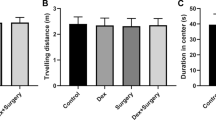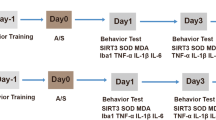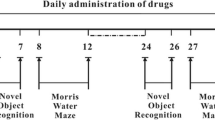Abstract
Postoperative cognitive dysfunction (POCD) is a common neurological disease affecting the elderly patients after surgery. Unfortunately, no effective treatment for this disease has been discovered. Edaravone, a clinical-used free radical scavenger, at 3 mg/kg has been reported to prevent neuroinflammation induced by the combination of surgery and lipopolysaccharide in adult rodents. However, we found that edaravone at such low concentration could not inhibit POCD in aged mice. Instead, edaravone at 33.2 mg/kg significantly prevented recognition and spatial cognitive dysfunctions in 14 month aged mice after abdominal surgery under general anesthesia with isoflurane. Furthermore, edaravone significantly prevented the increase of tumor necrosis factor-α (TNF-α), interleukin-1β (IL-1β) and interleukin-6 (IL-6) induced by abdominal surgery in aged mice. Edaravone could also decrease glial fibrillary acidic protein (GFAP) and ionized calcium binding adaptor molecule-1 (Iba-1) positive areas in the hippocampal regions of surgery mice, suggesting that edaravone might inhibit surgery-induced over-activation of microglia and astrocytes. Moreover, edaravone substantially increased the expression of PSD-95 and pSer9-glycogen synthase kinase-3β (pSer9-GSK3β) as demonstrated by Western blotting assay. Furthermore, the activity of acetylcholinesterase (AChE) is decreased in the mice in edaravone group. All these results suggested that edaravone at high concentrations could inhibit surgery-induced cognitive impairments in aged animals, possibly via the attenuation of neuroinflammation, the increase of synaptic proteins, and the elevation of cholinergic transmission, providing a further support that edaravone might be developed as a treatment of POCD.








Similar content being viewed by others
Abbreviations
- AChE:
-
Acetylcholinesterase
- ANOVA:
-
Analysis of variance
- DAPI:
-
4′,6-diamidino-2-phenylindole
- ELISA:
-
Enzyme linked immunosorbent assay
- GFAP:
-
Glial fibrillary acidic protein
- GSK3β:
-
Glycogen synthase kinase-3β
- Iba-1:
-
Ionized calcium binding adaptor molecule-1
- IHC:
-
Immunohistochemical
- IL-1β:
-
Interleukin-1β
- IL-6:
-
Interleukin-6
- LPS:
-
Lipopolysaccharide
- OD:
-
Optical density
- PBS:
-
Phosphate buffer solution
- POCD:
-
Post-operative cognitive dysfunction
- SD:
-
Standard deviation
- TNF-α:
-
Tumor necrosis factor-α
References
An LN et al (2013) Surgical trauma induces iron accumulation and oxidative stress in a rodent model of postoperative cognitive dysfunction. Biol Trace Elem Res 151:277–283
Ballard C et al (2012) Optimised anaesthesia to reduce post operative cognitive decline (POCD) in older patients undergoing elective surgery, a randomised controlled trial. PLoS One 7:e37410
Berger M et al (2018) Best practices for postoperative brain health: recommendations from the fifth international perioperative neurotoxicity working group. Anesth Analg 127:1406–1413
Bevins RA, Besheer J (2006) Object recognition in rats and mice: a one-trial non-matching-to-sample learning task to study ‘recognition memory’. Nat Protoc 1:1306–1311
Bilotta F et al (2013) Pharmacological perioperative brain neuroprotection: a qualitative review of randomized clinical trials. Br J Anaesth 110:i113–i120
Cao XZ et al (2010) Postoperative cognitive deficits and neuroinflammation in the hippocampus triggered by surgical trauma are exacerbated in aged rats. Prog Neuro-Psychopharmacol Biol Psychiatry 34:1426–1432
Chen LP et al (2017) Indirubin derivative 7-bromoindirubin-3-oxime (7Bio) attenuates a beta oligomer-induced cognitive impairments in mice. Front Mol Neurosci 10
Chen HX et al (2018) Tacrine(10)-hupyridone, a dual-binding acetylcholinesterase inhibitor, potently attenuates scopolamine-induced impairments of cognition in mice. Metab Brain Dis 33:1131–1139
Cui W et al (2014) Sunitinib produces neuroprotective effect via inhibiting nitric oxide overproduction. CNS Neurosci Ther 20:244–252
Dohare P et al (2014) The neuroprotective properties of the superoxide dismutase mimetic tempol correlate with its ability to reduce pathological glutamate release in a rodent model of stroke. Free Radic Biol Med 77:168–182
Farmer MA et al (2014) Pain reduces sexual motivation in female but not male mice. J Neurosci 34:5747–5753
Ghimire A, Bisset ES, Howlett SE (2019) Ischemia and reperfusion injury following cardioplegic arrest is attenuated by age and testosterone deficiency in male but not female mice. Biol Sex Differ 10:42
He F et al (2014) Inhibitory effects of edaravone in β-amyloid-induced neurotoxicity in rats. Biomed Res Int 2014:370368–370368
Huang L et al (2016) Sunitinib, a clinically used anticancer drug, is a potent AChE inhibitor and attenuates cognitive impairments in mice. ACS Chem Neurosci 7:1047–1056
Jiao SS et al (2015) Edaravone alleviates Alzheimer's disease-type pathologies and cognitive deficits. Proc Natl Acad Sci U S A 112:5225–5230
Jin WJ et al (2014) Minocycline improves postoperative cognitive impairment in aged mice by inhibiting astrocytic activation. Neuroreport 25:1–6
Jope RS, Yuskaitis CJ, Beurel E (2007) Glycogen synthase kinase-3 (GSK3): inflammation, diseases, and therapeutics. Neurochem Res 32:577–595
Kalb A et al (2013) Acetylcholinesterase inhibitors reduce neuroinflammation and -degeneration in the cortex and hippocampus of a surgery stress rat model. PLoS One 8:e62679–e62679
Kikuchi K et al (2013) The efficacy of edaravone (radicut), a free radical scavenger, for cardiovascular disease. Int J Mol Sci 14:13909–13930
Kong F et al (2013) Minocycline attenuates cognitive impairment induced by isoflurane anesthesia in aged rats. PLoS One 8:e61385
Li YJ et al (2014) Dexmedetomidine reduces isoflurane-induced neuroapoptosis partly by preserving PI3K/Akt pathway in the hippocampus of neonatal rats. Plos One 9
Li H et al (2018) Edaravone ameliorates experimental autoimmune thyroiditis in rats through HO-1-dependent STAT3/PI3K/Akt pathway. Am J Transl Res 10:2037–2046
Moller JT et al (1998) Long-term postoperative cognitive dysfunction in the elderly ISPOCD1 study. ISPOCD investigators. International Study of Post-Operative Cognitive Dysfunction. Lancet (London, England) 351:857–861
Peng L, Xu L, Ouyang W (2013) Role of peripheral inflammatory markers in postoperative cognitive dysfunction (POCD): a meta-analysis. PLoS One 8:e79624
Quan C et al (2019) BIS-guided deep anesthesia decreases short-term postoperative cognitive dysfunction and peripheral inflammation in elderly patients undergoing abdominal surgery. Brain Behav 9:e01238–e01238
Ragab HM, Teleb M, Haidar HR, Gouda N (2019) Chlorinated tacrine analogs: design, synthesis and biological evaluation of their anti-cholinesterase activity as potential treatment for Alzheimer’s disease. Bioorg Chem 86:557–568
Rappold T et al (2016) Evidence of an association between brain cellular injury and cognitive decline after non-cardiac surgery. Br J Anaesth 116:83–89
Rodionova E et al (2007) GSK-3 mediates differentiation and activation of proinflammatory dendritic cells. Blood 109:1584–1592
Rosas-Ballina M, Tracey KJ (2009) Cholinergic control of inflammation. J Intern Med 265:663–679
Rundshagen I (2014) Postoperative cognitive dysfunction. Dtsch Arztebl Int 111:119–125
Saeed A et al (2014) Synthesis, cytotoxicity and molecular modelling studies of new phenylcinnamide derivatives as potent inhibitors of cholinesterases. Eur J Med Chem 78:43–53
Sanders RD et al (2009) Dexmedetomidine attenuates Isoflurane-induced neurocognitive impairment in neonatal rats. Anesthesiology 110:1077–1085
Savioz A, Leuba G, Vallet PG (2014) A framework to understand the variations of PSD-95 expression in brain aging and in Alzheimer's disease. Ageing Res Rev 18:86–94
Su DS et al (2012) Isoflurane exposure during mid-adulthood attenuates age-related spatial memory impairment in APP/PS1 transgenic mice. Plos One 7
Szpak D et al (2018) α(M)β(2) is antiatherogenic in female but not male mice. J Immunol 200:2426–2438
Tian AY, Ma H, Zhang RW, Cui Y, Wan CF (2017) Edaravone improves spatial memory and modulates endoplasmic reticulum stress-mediated apoptosis after abdominal surgery in mice. Exp Ther Med 14:355–360
Tsukamoto A, Iimuro M, Sato R, Yamazaki J, Inomata T (2015) Effect of midazolam and butorphanol premedication on inhalant isoflurane anesthesia in mice. Exp Anim 64:139–145
Vlisides P, Mashour GA (2016) Perioperative stroke. Canadian journal of anaesthesia = Journal Canadien D'anesthesie 63:193–204
Wang HL, Ma RH, Fang H, Xue ZG, Liao QW (2015) Impaired spatial learning memory after isoflurane anesthesia or appendectomy in aged mice is associated with microglia activation. J Cell Death 8:9–19
Wang HL, Hua L, Xue ZG, Liao QW, Hao F (2016a) Minocycline attenuates post-operative cognitive impairment in aged mice by inhibiting microglia activation. J Cell Mol Med 20:1632–1639
Wang P et al (2016b) Protective effects of Edaravone in adult rats with surgery and lipopolysaccharide administration-induced cognitive function impairment. PLoS One 11:e0153708
Yatin SM, Varadarajan S, Butterfield DA (2000) Vitamin E prevents Alzheimer’s amyloid beta-peptide (1-42)-induced neuronal protein oxidation and reactive oxygen species production. Journal of Alzheimer’s Disease : JAD 2:123–131
Yuan Y, Zha H, Rangarajan P, Ling EA, Wu C (2014) Anti-inflammatory effects of Edaravone and Scutellarin in activated microglia in experimentally induced ischemia injury in rats and in BV-2 microglia. BMC Neurosci 15:1–21
Zhang ZJ, Li XH, Li FY, An LJ (2016) Berberine alleviates postoperative cognitive dysfunction by suppressing neuroinflammation in aged mice. Int Immunopharmacol 38:426–433
Zhao WX et al (2017) Acetaminophen attenuates lipopolysaccharide-induced cognitive impairment through antioxidant activity. J Neuroinflammation 14:17
Zucker I, Beery AK (2010) Males still dominate animal studies. Nature 465:690
Acknowledgements
This research was funded by the National Natural Science Foundation of China (81870853), Zhejiang Provincial Natural Science Foundation of China (LY19H250001), Medical Health Science and Technology Project of Zhejiang Provincial Health Commission (2019325190), Ningbo Sci & Tech Project for Common Wealth (2017C50042), Zhejiang Key Laboratory of Pathophysiology (201804), Ningbo municipal innovation team of life science and health (2015C110026), LiDakSum Marine Biopharmaceutical Development Fund, and the K. C. Wong Magna Fund in Ningbo University.
Author information
Authors and Affiliations
Corresponding author
Additional information
Publisher’s note
Springer Nature remains neutral with regard to jurisdictional claims in published maps and institutional affiliations.
Yiying Zhou and Xiang Wu contribute equally as co-first authors.
Rights and permissions
About this article
Cite this article
Zhou, Y., Wu, X., Ye, L. et al. Edaravone at high concentrations attenuates cognitive dysfunctions induced by abdominal surgery under general anesthesia in aged mice. Metab Brain Dis 35, 373–383 (2020). https://doi.org/10.1007/s11011-019-00532-y
Received:
Accepted:
Published:
Issue Date:
DOI: https://doi.org/10.1007/s11011-019-00532-y




